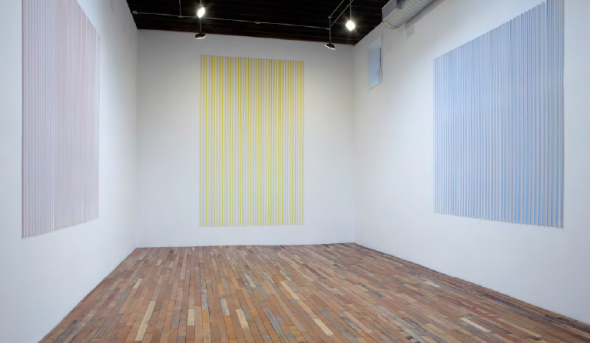From February 15 to March 27, 2019, Galleria Poggiali presents in its Milan location the exhibition Portrait of a Room, the first solo show of American artist Thomas Kovachevich(Detroit, 1942) in Italy, curated by Chiara Bertola.
Portrait of a Room brings together a body of works conceived by the artist specifically for the Gallery related to the material that has characterized and traversed his entire career: paper and its enormous possibility of life and transformation. It is a unique installation that enters into relationship with the cubic space of the project-room and with the large and bright window that opens onto Foro Buonaparte, creating an unexpected spatial depth. In the naturally lit space, Kovachevich took the simplest of materials (white packing tape and grosgrain ribbon) and created three separate works that feel both sculptural and painterly at the same time. Each wall tableau consists of long strips of grosgrain ribbon attached at the top and bottom to a thicker piece of ribbon. Hung one after the other, the strips create a square of vivid color that transforms with movement through space and moisture in the air. The paper strip moves and curls around the ribbon, breathing, living, transforming throughout the day as the humidity level in the room changes. The three large paintings on the gallery walls are not only a record of changes in the environment, but also represent a peculiar way of perceiving the room, making the invisible visible. When the paper ribbons glued to the grosgrain open and close, the whole wall vibrates and moves as if through the wind and air just as light vibrated in the en plain air fields of an Impressionist canvas.
“In order to tackle Thomas’s work made only of paper,” Chiara Bertola points out in her text in the catalog, “I had to put myself back to studying questions I had taken for granted about seeing and looking. I felt the need to pick up Rudolf Arnheim’s studies on perception and get help from the ancient wisdom of Socrates to remind myself that we do not see because we have eyes, but that we have eyes ’to see.’”
All it took for Thomas Kovachevich to transform the space of the gallery room into a frozen landscape were three cubes of rippled paper, a column made of transparent paper tubes and a group of silhouettes cut out of translucent paper that still allows light to pass through. The sensation is to find oneself in front of a landscape of icebergs, stalactites and geysers, where the semi-transparent shapes, gain volume and dimension by containing light within them.
Much of Kovachevich’s work has an intimate quality that plays between control and accident and invests geometry with emotional content. For the American artist, forms are rational explorations of geometry, and the emotional content inherent in his work consists of an irrational component. “I think one of the reasons I was attracted to minimalism,” Kovachevich himself says, “was its attempt to define purity. However, in my work I have always tried to invest geometry with emotional content.”
Thomas Kovacevich is part of that generation of artists in America in the late 1960s and early 1970s who explored the idea of dematerializing art to make the creative process accessible to the public; he approaches Process Art research and uses natural and industrial materials by comparing them to enhance the primary expressiveness of their physical properties. Artists most akin to him are Richard Tuttle for his use of materials, James Lee Byers who makes the invisible his art, and Tom Shannon who plays with the wonder of science.
Harald Szeemann and Jean-Christophe Ammann, who invited him to Documenta 5 in 1972, included him in a group of artists and spoke for the first time of “individual mythologies.” Today his works are held within very important international collections, among them that of the Bern Kunst Museum in Bern, that of the Hammer Museum in Los Angeles, that of the Museum of Contemporary Art in Chicago that of the Museum of Jurassic Technology in Los Angeles, and that of the Museum Marseille/Cantinni in Marseille. A catalog with critical text by Chiara Bertola will be published for the occasion.
For all information you can call +39 02 72095815 or visit the official website of the Poggioli Gallery.
To learn more about Thomas Kovachevich you can visit his official website by clicking here.
 |
| In Milan, Poggiali hosts the first Italian solo exhibition of Thomas Kovachevich |
Warning: the translation into English of the original Italian article was created using automatic tools. We undertake to review all articles, but we do not guarantee the total absence of inaccuracies in the translation due to the program. You can find the original by clicking on the ITA button. If you find any mistake,please contact us.